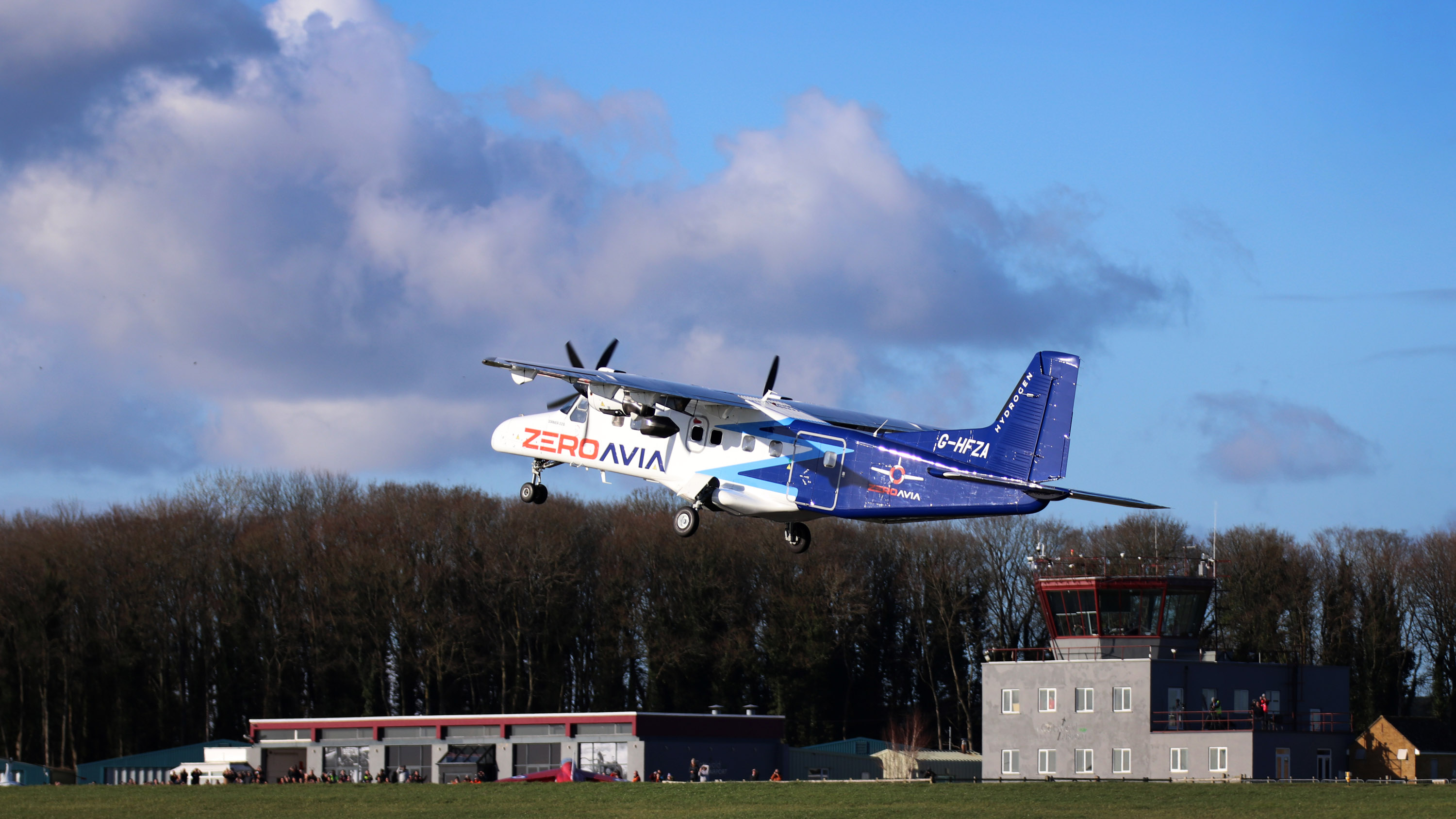Hydrogen-powered planes take off with startup’s test flight
The plane is the largest to fly powered in part by a hydrogen fuel cell, a significant step for zero-emissions flight.

In a record trip for low-carbon aviation, a startup has completed a test flight of a 19-seat aircraft powered in part by hydrogen fuel cells. It’s the largest plane that ZeroAvia, a leader in developing hydrogen-electric systems for planes, has tested in the air to date.
The flight took off from Cotswold Airport in the UK and lasted about 10 minutes altogether. During the flight, the plane’s left engines were powered by a combination of hydrogen fuel cells and batteries, while the right side relied on the fossil fuel kerosene.
Aviation accounts for about 3% of global greenhouse gas emissions, and the industry is growing quickly. While airlines and some industry groups have pledged to cut emissions to net-zero by 2050, the demands of flying are difficult to achieve without fossil fuels.
Hydrogen fuel cells represent one possible route that some companies hope can help reduce emissions from the aviation industry, but to make significant cuts, the technology would need to be scaled up to power relatively large aircraft.
“This is putting us straight on the path to commercial launches,” said Val Miftakhov, ZeroAvia founder and CEO, in a press conference announcing the results of the test flight.
ZeroAvia has raised over $140 million in funding from investors, including United Airlines and American Airlines, as well as Breakthrough Energy Ventures, Bill Gates’s energy venture fund. The company has also received over 1500 pre-orders from customers for its hydrogen fuel-cell systems, according to Miftakhov.
The startup has been flying test flights for several years with smaller planes, with varying degrees of success. In 2021, one was forced to land and the plane was damaged after the battery backup system was shut off. With only the hydrogen fuel cells running, the plane lost power to its electrical motors.
The battery system supported the recent January 2023 test flight of the 19-seat plane, which was delayed from summer 2022. Batteries supplied about 50% of the power to the left side of the aircraft for the whole flight, with the hydrogen fuel cell system supplying the other 50%.
By combining oxygen in the air with hydrogen, fuel cells generate electricity that can power a plane while releasing only water into the atmosphere. The seats of ZeroAvia’s test plane, a Dornier 228, were taken out to make room for the fuel cell propulsion system and the hydrogen tanks that power it.
Universal Hydrogen, a US-based startup also working to build hydrogen-electric propulsion systems for planes, is reportedly planning test flights for its retrofitted Dash 8-300, a 50-seat aircraft, in early 2023.
Despite delays and issues with testing, Miftakhov said that ZeroAvia is still on track to meet its previously announced plans for commercial launch in 2025. He declined to share what type of plane would be used and which commercial partner was involved, but he said the aircraft will have between 10 and 20 seats. The company plans to raise additional funds to support commercialization, Miftakhov said at the press conference.
“This is a wonderful first step, but of course it’s only the first step,” says Andreas Schafer, director of the Air Transportation Systems Lab at University College London.
Small, short-range commercial aircraft could be powered by hydrogen fuel cells within the decade, Schafer says. But those routes represent a small fraction of the aviation industry today. “It’s really peanuts in terms of energy use and emissions,” he says.
Technologies that can power larger flights for longer distances will have a much greater impact on addressing climate change, according to Schafer. But scaling fuel cells to larger planes will be difficult, in part because fuel cells are heavy. In addition, finding space for hydrogen storage on planes can be tricky, because the fuel is much less energy-dense than kerosene, requiring higher volumes of fuel on board even if it’s cooled to cryogenic temperatures so that it can be stored in liquid form.
Plenty of obstacles remain before zero-emissions commercial flights can become a reality, Miftakhov acknowledged at the press conference: “Today we have witnessed a major step toward achieving that goal. But there’s a lot of work still to do.”
Deep Dive
Climate change and energy
The problem with plug-in hybrids? Their drivers.
Plug-in hybrids are often sold as a transition to EVs, but new data from Europe shows we’re still underestimating the emissions they produce.
Harvard has halted its long-planned atmospheric geoengineering experiment
The decision follows years of controversy and the departure of one of the program’s key researchers.
Why hydrogen is losing the race to power cleaner cars
Batteries are dominating zero-emissions vehicles, and the fuel has better uses elsewhere.
Decarbonizing production of energy is a quick win
Clean technologies, including carbon management platforms, enable the global energy industry to play a crucial role in the transition to net zero.
Stay connected
Get the latest updates from
MIT Technology Review
Discover special offers, top stories, upcoming events, and more.